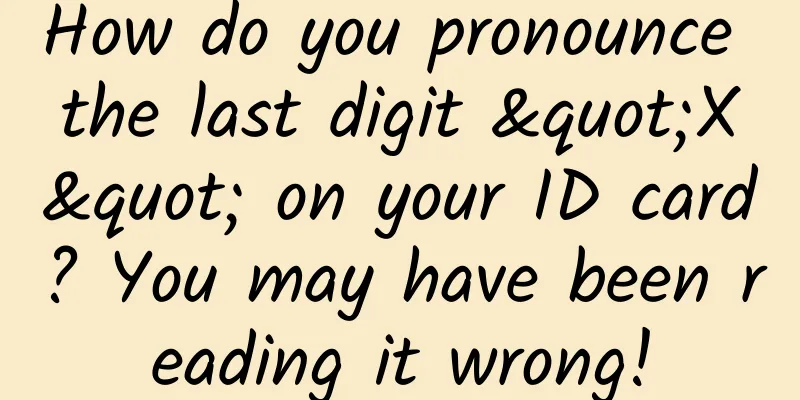How do you pronounce the last digit "X" on your ID card? You may have been reading it wrong!

|
How do you pronounce the last digit "X" on your ID card? You may have been reading it wrong! In the information age, whether it is online shopping or traveling, we cannot do without a small ID card. If there is any number that can be imprinted in the depths of memory, besides pi 3.141592653, it is probably everyone's ID number. However, people’s joys and sorrows are not shared. For people whose ID numbers end with X, every verification and input is a test. Image source: Weibo screenshot Recently, the pronunciation of X has become a hot topic: Image source: Weibo screenshot So, what’s the deal with the X at the end of the ID number? The X in ID numbers actually has a very recent origin If you want to understand this "suspicious number" X, you need to know where the series of numbers in the ID number come from. In fact, ID cards have not been around for very long. As early as the early days of the founding of the People's Republic of China, if you wanted to prove that "I am me", you needed a household registration booklet and a letter of introduction from your employer. It was not until 1984 that the State Council issued the "Trial Regulations on Resident Identity Cards of the People's Republic of China", and the first generation of identity cards was born. The identity card number appeared in 1999. The "Decision of the State Council on the Implementation of the Citizen Identity Number System" defines it as: a unique and lifelong identity code assigned to every Chinese citizen from birth. To put it simply, it can be understood as your own unique anti-counterfeiting code. However, the ID number at that time only had 15 digits and did not have the X symbol. X really came into circulation in 2004, when the second generation of ID cards was issued. Compared with the 15-digit ID card number of the previous generation, the second generation ID card has 18 digits, and the 7th, 8th and 18th digits are added. The question is, since it can be announced at the legal level and applied to everyone, there must be a reason for it. What do these numbers in the ID number represent? The first 6 digits represent the administrative division code of the permanent residence when applying for a resident ID card, from province and city to district and county. Many people will type the number 110 on social platforms, but don’t think too much about it. They may not be asking for help, but want to say: I am a native Beijinger. For example, the code for Chaoyang residents is 110105, where 11 is the province code, 01 is the Beijing district code, and 05 is the Chaoyang district code. The 7th to 14th digits of the ID card are easy to understand, representing a person's date of birth. The 7th and 8th digits added to the second-generation ID card are the first two digits of the Gregorian calendar. There is no way around it. In the last century when ID cards were first created, most people started with 19, so there was no need to write them down. In the new century, more and more people are starting their years with 20. If it is not introduced, it will cause ambiguity. The 15th to 17th digits of the ID card are sequential codes. The first two are the code of the local police station, and the 17th is the gender code . Generally speaking, an odd number indicates a male, and an even number indicates a female. But there are occasional exceptions. Now comes the point. What does this 18th number, which has been around for less than 20 years, represent? In fact, it is the verification code of the ID card . Its existence allows people to quickly check whether the ID card number is entered incorrectly. X is just a special form of the security code The verification code of the ID card number adopts the "MOD11-2" verification code system in "ISO7064:1983" established by the International Organization for Standardization ISO. When you accidentally enter a wrong word and the system is completely unaware of it, this system can help you detect the loophole with 100% accuracy. First, multiply the first 17 digits of the ID number by different coefficients: 7, 9, 10, 5, 8, 4, 2, 1, 6, 3, 7, 9, 10, 5, 8, 4, 2 and add the results. Then, divide the sum of these results by 11 and get the remainder. In order to protect citizens' privacy while making it easier for everyone to understand, here we use Wei Xiaobao, a popular actor in the TVB version of "The Deer and the Cauldron", as an example. According to the above rules, his ID number is multiplied by different coefficients, and the following results are obtained: The sum of these products is 217, which is 19 divided by 11 with a remainder of 8. This remainder 8 is the key number we want to lock on. From 0 to 10, each remainder has its corresponding numerical value, and this numerical value is the 18th digit in our ID number. Source: National Standard "Citizen Identity Number" GB11643-1999 The check code corresponding to the remainder 8 is 4, so it is obvious that Wei Xiaobao’s ID number is fake. At this point, the true identity of X is revealed. It is just the check code corresponding to the remainder 2. There are 10 remainders in total, so there will naturally be 10 check codes, but 10 is a two-digit number, which will directly make the ID number transition to 19 digits. In order to facilitate information management, the Roman numeral X is used instead of the Arabic numeral 10. After mastering the above methods, you can also try to calculate how scientific your ID number is. No wonder some people say that learning mathematics well can effectively prevent fraud. This system is not only applied to ID card numbers. According to the above method, you can even infer whether the books you purchased are pirated. Because the ISBN number of a book is also called the International Standard Book Number, the same method is adopted. The first 9 digits representing the country code, publisher code, and type code are multiplied by different coefficients, added together, and finally it is deduced whether the number is divisible by 11. If it is divisible by 11 by 6, then the tenth digit of the book, which is the check digit, will eventually be determined to be 6. How to read X correctly There are many different opinions on how to pronounce the ending X. Some people would adopt the same pronunciation as Guan Xiaotong, who pronounced "你xx" as "你叉叉", and pronounce it as "叉(cha)". Others would like to be more fashionable and refer to the pronunciation of foreign telecommunications companies, such as Iphone X, which is pronounced as i phone ten in foreign countries. It means the tenth generation of Apple mobile phone. If we look into the original meaning and adapt to local conditions, we can directly read X as 10. For the sake of convenience, when dealing with things, we should report the ID number or read it in the way that everyone is used to. Whether it is a cross or a ten, in the final analysis, it is just for the convenience of understanding. References [1] Yao Xianfeng. How to use Excel to read relevant information of the second-generation ID card [C]. Proceedings of the 2013 Annual Conference of Jiangsu Surveying and Mapping Society., 2013: 123-124 [2]GA/T 448-2021 General Technical Requirements for Resident Identity Cards. https://hbba.sacinfo.org.cn/attachment/onlineRead/a90a5a366e77dd80a07c5ef29df56bcc8fe1d92996727162f185eeff93ceaea7 [3] GB11643-1999 Citizen Identity Number. https://openstd.samr.gov.cn/bzgk/gb/newGbInfo?hcno=080D6FBF2BB468F9007657F26D60013E Planning and production This article is a work of Science Popularization China-Starry Sky Project Produced by: Science Popularization Department of China Association for Science and Technology Producer|China Science and Technology Press Co., Ltd., Beijing Zhongke Xinghe Culture Media Co., Ltd. Author: Li Mi, popular science creator Review丨Lin Yuzhi, Executive Deputy Director of the Science and Film Integration Committee of the China Science Writers Association Planning丨Yang Yaping Editor: Yang Yaping |
<<: Can you reach this pace? Diabetes risk may be reduced by 39% →
>>: Boil the sea to make salt! Ancient "Shandong people" used "big helmets" to boil salt?
Recommend
Clothing wholesale WeChat applet, how to develop clothing WeChat applet?
Q: How to develop a WeChat applet for clothing wh...
Technical tips! "Ya Ya", "Meng Lan", "Hua Hua"... How to distinguish who is who among so many pandas?
After about 16 hours of flight, the cargo plane c...
iPhone 6 Plus camera issue: Can't focus
On November 20, the iPhone 6 Plus not only restar...
How do Tmall and Pinduoduo promote their activities during the 618 shopping festival?
The largest 618 battle in history officially star...
The underlying logic behind Weilong spicy strips marketing!
At the end of last year, it was reported that Wei...
What are the functions of the outbound travel mini program? How much does it cost to make an entry and exit mini program?
With the continuous development of China's ec...
In-depth analysis of Android dynamic management fragment: "Do you know these components?"
1. The relationship between Fragment and Activity...
Zhai Shanying: Find out the secrets of capital making money
Tutorial Introduction Companies that do not under...
Google is rectifying the Android ecosystem and will force mobile phone manufacturers to provide security patches
In terms of system security, Android has always b...
How to build a user tag system from 0-1?
With the disappearance of traffic dividends, the ...
8 practical summaries on improving community retention
Brands often consult Da Nian. The company has obv...
Attracting new users: 4 tips to increase the sharing rate of old users bringing in new users
How to increase the frequency of referral sharing...
The official version of iOS 16.3.1 is here, and several new features will be released soon!
A few days ago, Apple pushed the official version...
PC shipments continue to decline, domestic mobile phone competition is still unresolved, Lenovo's future lies overseas
Lenovo Group released its financial report for th...
How long will it take for humans to hibernate? Not far away!
For some species, when external conditions become...






![[Case] How to promote mobile medical APP in an embarrassing situation!](/upload/images/67cc3dc020041.webp)


